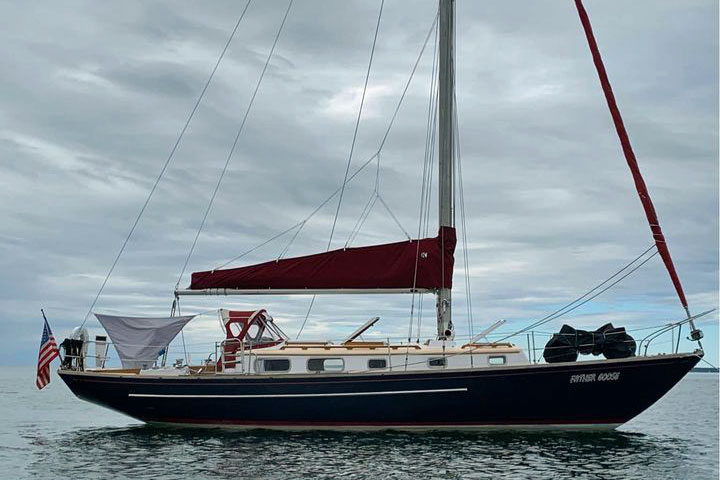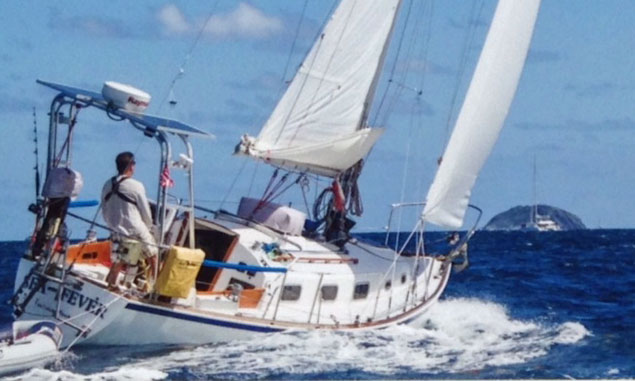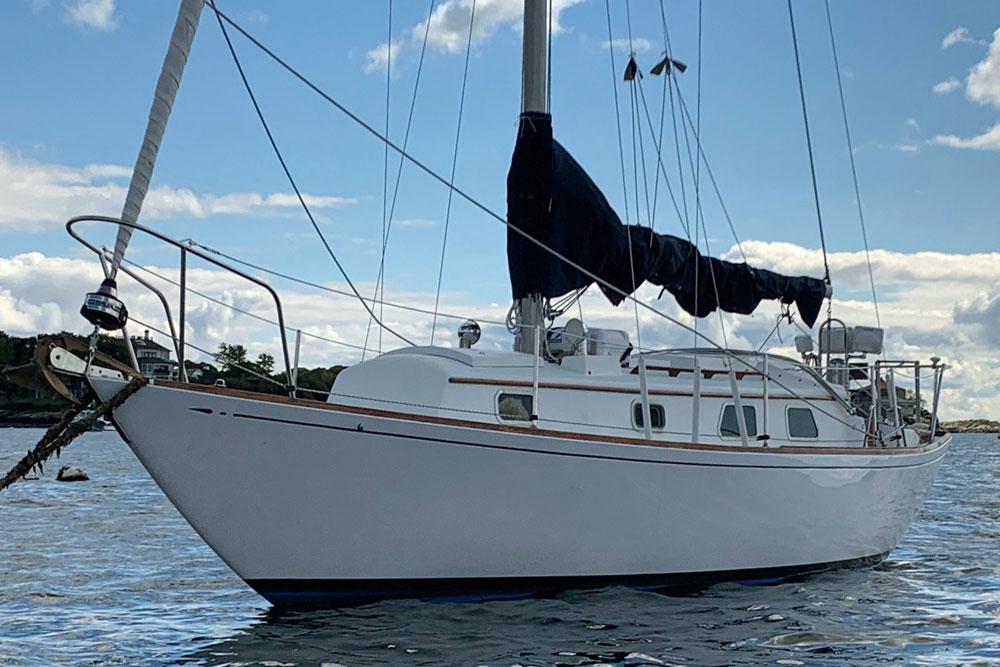- Home
- Bristol Sailboats
Bristol Yachts: A Legacy of American Seafaring
The name Bristol Yachts instantly conjures images of robust construction and graceful lines, a true hallmark in American sailing history. From its inception in the mid-1960s until its eventual closure, Bristol consistently delivered a diverse fleet of sailboats.
 Bristol 40
Bristol 40These vessels, celebrated for their resilience, comfort, and offshore capabilities, became a top choice for sailors tackling everything from leisurely coastal cruises to challenging bluewater passages. Let's explore the company's fascinating journey, its design philosophy, standout models, and the indelible mark it left on the sailing world.
The Bristol Story: Roots & Vision
The story of Bristol Yacht Co. began in 1966 in Bristol, Rhode Island. The founder was Clint Pearson, a visionary who had previously co-founded Pearson Yachts, a true pioneer in fiberglass boatbuilding. Pearson’s inspiration? A keen eye for the emerging potential of fiberglass in marine construction. Right from the start, Bristol Yachts quickly earned a reputation for its unwavering commitment to solid craftsmanship and stoutly built vessels.
Over its roughly three-decade history, Bristol Yachts saw significant evolution, expanding its offerings and collaborating with a pantheon of celebrated naval architects. While they did dabble in powerboats—like the Bristol 42 Offshore Trawler—the company's heart truly remained with sailboats. Bristol Yachts ultimately ceased production in 1997, leaving behind a fleet of over 4,000 vessels. The company's underlying philosophy always revolved around delivering well-finished boats, renowned for their unwavering quality and impressive durability.
 Bristol 29.9
Bristol 29.9Designing Dreams: Evolution & Iconic Models
Bristol Yachts was fortunate to collaborate with an impressive roster of naval architects, including Carl Alberg, Halsey Herreshoff, Ted Hood, and Dieter Empacher. Each left their unique imprint, shaping the distinctive character that defined Bristol's fleet.
Early models, such as the Bristol 27 (Carl Alberg's design and the company's inaugural offering), set a tone for classic, traditionally styled boats. The Bristol 32 and Bristol 40, both constructed between 1966 and 1977, beautifully exemplify this timeless aesthetic. However, by the mid-1970s, shifting market demands called for more modern styling and greater interior volume. Bristol adapted, introducing models like the Bristol 29.9 and Bristol 35.5 in 1977. These designs embraced contemporary trends while staunchly upholding Bristol's hallmark quality.
Among Bristol's most cherished and influential sailboats, several truly stand out:
Spotlight on Key Bristol Models
- The Bristol 24: Penned by Paul Coble and hitting the water in 1964 (sometimes known as the Sailstar Corsair or Bristol Corsair), this model sports a long keel, a masthead sloop rig, and a hull of unwavering fiberglass. Displacing 5,920 lbs with 3,000 lbs of ballast, she's a true heavy displacement cruiser, promising a comfortable ride even when the seas get lumpy. Surprisingly roomy for her size, the Bristol 24 features a five-foot cockpit, two cabins, and six feet of headroom in the saloon. While renowned for her extreme stiffness, her substantial wetted area and conservative sail plan sometimes meant she was a bit slower than some of her contemporaries.
- The Bristol 29.9: Designed by Halsey Herreshoff and launched in 1977, this fiberglass masthead sloop offered either a fin keel with a skeg-mounted rudder or a stub keel with a centerboard option. Weighing in at 8,650 lbs with 3,600 lbs of lead ballast, her design ratios suggest a boat that handles well in a blow, offering responsive helm control thanks to her generous rudder and skeg. Interior layouts varied, but typically included a V-berth, a head, and enough space to sleep up to six.
- The Bristol 32: Primarily the work of Ted Hood and Dieter Empacher, the Bristol 32 saw production from 1966 to 1983. This masthead sloop sports a modified full keel and solid fiberglass laminate construction. At 10,800 lbs displacement with 3,900 lbs of ballast, she's widely praised as a stable, smooth-riding bluewater cruising boat, performing admirably across diverse wind conditions. A minor note for potential owners: the original fuel capacity was on the smaller side.
- The Bristol 40: A Ted Hood design, built from 1970 to 1986, the Bristol 40 is often hailed as a "masterpiece," even earning a spot on Cruising World's list of "40 all-time best monohulls." This masthead sloop features a modified long keel with a cutaway forefoot, enhancing maneuverability without sacrificing stability. She displaces 17,580 lbs with 6,500 lbs of lead ballast. Her interior, frequently praised for its warm, traditional wood finishes (often Scandinavian pine), provides comfortable liveaboard accommodations, including a V-berth, a convertible dinette, settees, and a quarter berth. Her sail area-to-displacement ratio suggests she offers satisfying performance for most cruising sailors.
 Bristol 32
Bristol 32Beyond the Core: Other Notable Bristol Yachts
Models like the Bristol 35.5, 38.8, 41.1, and 45.5, particularly those in the "Custom" series, were specifically engineered for extended bluewater cruising, setting high standards for offshore safety and comfort. The Bristol 35.5, for instance, remains a timeless design, still sought after decades later. The Bristol 41.1 is admired for its robust build and inviting interior, while the Bristol 45.5 is a top pick for liveaboard comfort and long-range voyages.
Built Tough: Bristol's Construction Quality
Bristol Yachts’ stellar reputation for exceptional build quality and durability largely stems from their extensive use of fiberglass. Early advertisements for vessels like the Bristol 42 Offshore Trawler proudly touted "handlaid, completely American-built, all fiberglass construction," though some production did later move overseas.
Hulls were generally molded in a single piece, often without core material, which greatly contributed to their impressive strength. Decks, on the other hand, typically featured balsa coring for added stiffness and insulation. Interiors showcased high-quality wood trim—mahogany in the Bristol 29.9, Scandinavian pine in the Bristol 40—reflecting a dedication to traditional craftsmanship and a cozy aesthetic. This focus on stout construction ensured remarkable longevity, transforming Bristol yachts into truly reliable vessels that have admirably weathered the decades.
On the Water: Performance & Comfort
Bristol sailboats generally offer a stable and comfortable experience under sail. The variety of keel configurations—from the traditional full long keels of early models (like the Bristol 24 and 32) to the more modern fin keels with skegs or centerboards seen in later designs (like the Bristol 29.9 and 40)—provided diverse sailing characteristics to suit different preferences.
Many Bristol models, especially those conceived by Ted Hood and Halsey Herreshoff (think Bristol 32, 40, 41.1, and 45.5), were purpose-built for offshore or extended cruising. Their designs prioritized bluewater safety and overall seaworthiness. The Bristol 40, dubbed a "proven racer-cruiser," actually boasts decent speed for a boat intended for cruising. Even the smaller Bristol 24, with its heavy displacement, surprisingly offers the kind of smooth motion typically found on much larger boats and can, with the right setup, be adapted for ocean passages.
Inside, layouts were conceived with both liveability and practicality firmly in mind. The Bristol 24, despite its compact size, offered impressive headroom and versatile sleeping arrangements. The Bristol 29.9 provided options for galley configurations and could comfortably sleep six. The Bristol 40's interior, adorned with rich wood, generous sleeping areas, and a well-appointed galley, clearly emphasized long-term liveaboard comfort and extended voyages.
Thinking of Buying? What to Look For
If you're considering a pre-owned Bristol sailboat, here are some common characteristics and points to keep an eye on:
- Robust Construction: Bristol boats are known for their strong fiberglass construction, a major factor in their remarkable longevity.
- Timeless Aesthetics: Many models, especially the earlier ones, feature classic lines and interiors rich with warm, traditional wood.
- Offshore DNA: A strong emphasis on seaworthiness and stability means many Bristol models are genuinely capable offshore boats.
- Designer's Touch: The influence of design luminaries like Ted Hood and Halsey Herreshoff is clearly visible in the sailing performance and interior layouts across various models.
- Keel Diversity: Be prepared for a range of keel types throughout the model line, including long keels, modified full keels, and fin keels with skegs or centerboards.
- Engine Considerations: Older models might still have their original gasoline engines (like the Universal Atomic 4 in the Bristol 32 and 40), though many have likely been repowered with diesels (e.g., Yanmar or Universal). Always dig into the engine's condition and maintenance history.
- Upgrade Potential: Given their age, most Bristol models will probably have seen upgrades to electronics, rigging, and other systems. Carefully assess the quality and thoroughness of these enhancements.
Common criticisms are usually minor and often specific to certain models. The Bristol 24, for instance, might be a tad slower than some boats of its era, and the Bristol 29.9 was once described as "less-than-sprightly." The Bristol 32 originally came with a somewhat small fuel tank. These points are generally understood and accepted as part of their inherent design characteristics.
Bristol's Lasting Impact
Bristol Yachts left an indelible mark on the sailing world. The brand’s reputation for crafting durable, comfortable, and seaworthy fiberglass sailboats firmly established its standing as a respected builder. Though production has ceased, the sheer number of Bristol boats still actively sailing today speaks volumes about their enduring quality and broad appeal.
A vibrant community of Bristol owners thrives, evident from the continuous listings and lively discussions on platforms like YachtWorld and TheYachtMarket. This fosters a strong sense of camaraderie and mutual support among enthusiasts. The company's contribution to sailboat design and construction, particularly in the realm of production fiberglass yachts, remains profoundly significant. Even on the used market, Bristol models consistently retain their value, a powerful testament to their timeless design and superior build.
While Bristol Yachts may no longer be launching new vessels, their enduring fleet continues to explore oceans and coastlines worldwide, serving as a powerful, living reminder of a company that truly championed craftsmanship, comfort, and the sheer joy of being on the water.
Sources & References
- "Bristol 42 Offshore - Soundings Online" https://soundingsonline.com/boats/bristol-42-offshore/
- "Bristol 42 Offshore Trawler - Soundings Online" https://soundingsonline.com/boats/bristol-42-offshore-trawler/
- "Bluewater Sailboat – Bristol 24" https://oceanwavesail.com/explore-sailing/bluewater-sailboats/bluewater-sailboat-bristol-24/
- "Bristol 29.9 - Wikipedia" https://en.wikipedia.org/wiki/Bristol_29.9
Recent Articles
-
Modern Boat Electronics and the Latest Marine Instruments
Dec 20, 25 05:27 PM
Should sailboat instruments be linked to the latest boat electronics as a fully integrated system, or is it best to leave them as independent units? -
Hans Christian 43: Classic Bluewater Cruiser & Liveaboard Sailboat
Dec 10, 25 04:37 AM
Explore the Hans Christian 43: a legendary heavy-displacement, long-keel sailboat. Read our in-depth review of its specs, design ratios, and suitability for offshore cruising and living aboard. -
Planning Your Sailboat Liveaboard Lifestyle: An Ocean Sailor's Guide
Dec 06, 25 05:18 AM
Seasoned sailors share their methodical risk analysis for planning a secure Sailboat Liveaboard Lifestyle, covering financial, property, and relationship risks.












